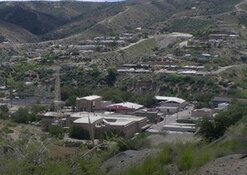The Energy Report: John, you write the Kaiser Bottom-Fish mining newsletter. How long have you been doing that and how has the business changed in that timeframe?
John Kaiser: I have been involved in the junior resource sector since 1983 and as an independent newsletter writer/commentator since 1994. The first two decades of my career were focused largely on exploration-style discoveries where you find a new gold or nickel or diamond deposit and the stock goes from pennies to multiple dollars.
Since 2003, the focus has shifted to a more development-oriented market where we look at the ounces and pounds in the ground. Now the game is conduct prefeasibility level work on a project, upgrade it, prepare it for a mining decision and, hopefully, a buyout by a major mining company.
This has required the junior miners to move up the learning curve in terms of what they do as mining executives. This has been helped by the migration of technical personnel from the big mining companies as the majors have adopted more of an outsourcing attitude toward their exploration needs.
TER: By outsourcing you mean the junior mining companies have essentially become the exploration arms of the majors?
JK: Majors have cut back their internal exploration departments and now use the internal manpower to do advanced feasibility and development work. Majors really rely on the juniors to discover projects and conduct the "dressing up" work necessary for their number crunchers.
Major companies are monitoring what the juniors are doing in a very big way. And the majors compete with each other when a project reaches critical mass.
Interestingly, as Asia has emerged as a major economic force, state-owned Chinese mining entities have joined the fray as competitors in buying these assets. And they often pay more than the western number crunchers were willing to pay because they refused to accept that higher real base metal prices are the new reality. It was not until 2006 that they stopped forward selling copper and other metals and realized something different was going on.
China is emerging and it's causing a paradigm shift in demand. For 50 years it was the normal boom-bust business cycle driven by western economies but a new force is now at work. The whole world is now sucking up raw materials.
TER: Well, that's certainly one of your consistent messages when you're speaking at mining conferences. The emerging economies of countries like China and India will continue to drive demand for base metals. Tell us about some metals that you believe will see some significant price appreciation and why.
JK: I think all the base metals are destined for higher prices. None of them are quite at the high that they achieved in early 2008 before the financial meltdown.
China bailed itself out by deciding to spend $600 billion over two years on infrastructure development. Transportation and energy infrastructure is being pushed inland where there is a large rural population.
China has realized that its dependency on the United States as an export market makes it vulnerable to the destiny of the United States as a viable economy and is now doing everything it can to develop a domestic economy that can sustain its growth.
That means you have raw materials such as copper and nickel and zinc being used for transportation infrastructure. At the same time, there is an emerging middle class and as these people get wealthier they will want fridges, air conditioners—all the things we take for granted.
So you have two sources of long-term demand growth: infrastructure consumption and consumer-based goods consumption. Now we have copper going higher. We have nickel rebounding. It was at $25 a pound in 2007 before it crashed to about $4. Now it's back in the $10 range. Zinc has been the laggard and that's mostly because there are many zinc mines in China. Zinc isn't expected to be in deficit until at least another year from now. Right now, zinc is a bottom-fish metal.
But what's become interesting in the last couple of years are the so-called "minor metals" or rare earth elements (REEs). These are the "magic metals" of the future because of their unusual properties. They have a total annual market value of only $20 to $22 billion compared to $130 billion for base metals and $90 billion for precious metals.
About 97% of global supply of REEs comes from China, which has recognized that these metals are not linked to the usual global business cycle. These metals have demand trajectories emerging from shifts toward renewable energy and other innovations as new ways to take advantage of the unique properties of these elements are discovered. You could see demand growth in these metals go far beyond the GDP growth or infrastructure related growth.
TER: But with China accounting for 97% of REEs production, we've recently seen them use that control for political leverage. For example, recently there was a Chinese captain of a fishing trawler who was detained by Japanese officials; soon after the Chinese cut off exports of rare earths to Japan.
That was the first time the world saw that China was willing to use its REEs supply to play politics. That had to send some shivers around the world in terms of companies and countries that need steady supplies of these metals.
JK: I suspect that's probably an exaggeration. The Chinese have adamantly denied formally restricting rare earths exports to Japan in retaliation for the fishing captain incident.
But what is clear is that they have told REEs suppliers not to deal with Japanese traders. Japanese traders who have been trying to get what they can from the 8,000 tons of REEs made available for the second half of 2010 have noticed that nothing's coming through.
But this was coming anyway because China has realized that the demand trajectory for REEs is far beyond what anybody imagined 20 years ago when China started to dominate the REEs sector. There are finite resources of REEs, especially in the heavy rare earths, which are being used in some impressive new technologies.
This year China embarked on a major consolidation of the industry to cut down on emissions. The Chinese allow these rare earth projects to operate at standards that would be completely unacceptable in the West. But the Chinese don't want to live in a cesspool so they are shutting down their polluting operations and embarking on a lot of clean technology initiatives.
They're also cracking down on a major heavy rare earths smuggling operation. These are rare earths going out of the country without any export taxes. These have been going to Japan and Korea and from there onto the United States.
TER: Is that why China controls 97% of the market? Is it because we didn't want the environmental problems associated with developing and processing REEs?
JK: Yes, but it's also sort of the so-called neoliberal policy of the last 30 years where you allow capital to go to the lowest cost jurisdiction; the one willing to endure the greatest sacrifices in terms of wages, working conditions and environmental impact. China has literally prostituted itself in this regard while thinking: "If I do this now I will have them by the you-know-whats down the road."
That time is now for REEs. However, I don't think China's long-term strategy is to extort the West. They actually want REEs supply to emerge elsewhere. They've created a two-tier pricing system whereby we have a composite of the primary rare earths available for export markets trading at two to three times higher than the domestic price. They've setup a situation where as the world makes the transition to developing its own rare earth deposits outside of China, anybody that in the interim needs rare earths for their products is being encouraged to setup manufacturing shops in China so that they don't have supply disruptions. Of course, that's not going over very well because that's extortion.
However, that's the West's punishment for being a cost dumper years ago and not thinking about security of supply. That's the awakening that's happening in all kinds of metals right now. I mean we see it even in tungsten where China produces 90% of the world's supply. Toolmakers are being encouraged to build their tool making factories in China, too. China is in a sense exacting some payback for our earlier exploitation of them.
TER: And to a certain extent funding their infrastructure development along the way.
JK: Yes. Keep in mind that these metals are minor in terms of total market value. At the prices that prevailed in 2009, the rare earths market was estimated to be worth between $1 to $2 billion. So what's the big deal, right? The unfortunate thing is there are no substitutes for the properties that these REEs have. They are critical to the viability of hundreds of billions perhaps even trillions of dollars worth of consumer and technology goods.
Of course, the U.S. military has become a little antsy because although they do not need a lot of REEs for sophisticated military applications it's very inconvenient to realize you have to wait three months for somebody to source some terbium for one of its classified operations. That's a concern that has various politicians lobbying the government to enact legislation that would support Western rare earth mining operations.
The concern is that the Chinese can let the freight on board (FOB) prices rise in the meantime and everybody says, "Alright, at these prices it all works. Let's invest the capital into these projects." Then when we finally have them up and running the Chinese flood the market with surplus REEs produced with significant subsidies. Then all these projects are no longer viable.
TER: What about some sort of subsidy program in the West?
JK: Perhaps or at least perhaps a tariff where China could not dump its REEs into the market.
My view is that REEs are a difficult commodity to treat in the same manner as traditional mining. I expect that end-users—giant manufacturing conglomerates—will end up acquiring these rare earth projects and operate them like in-house chemical plants. They won't really care what the market prices are because they will not be selling them. They will simply stockpile it and develop their manufacturing plans because they have security of supply.
TER: Are you suggesting that these large corporations like LG or Toyota Motor Corp. (NYSE:TM) are going to come in and take out these companies with significant REEs deposits or are we talking about off-take agreements?
JK: No, off-take agreements require the mining entity to somehow be economically viable. That creates a vulnerability because if they're not making money it shuts down and the end users lose their REEs supply.
The end-users need to own them to keep them operating, preferably at a low enough cost that the hundreds of billions of dollars of products they want to sell is not affected.
The key concept that's at play here is opportunity cost. Toyota is a good example. Why are they not selling millions of the very popular Toyota Prius hybrids? The reason is these nickel-metal hydride batteries require lanthanum. There isn't enough lanthanum securely available to scale production to that level. If Toyota owned a mine that produced a lot of surplus of lanthanum, then it could actually start planning to make an awful lot of Prius hybrids three or four years down the road.
It's this ability to scale up commercialization of technologies that are the real profit drivers for these end-user companies. They would make nothing on the rare earth asset but the security of supply provided by that asset enables them to make enormous profits on product commercialization.
TER: That certainly seems more reliable than Chinese smugglers. Let's talk more about lanthanum. What are some deposits with some high lanthanum grades?
JK: Well, that would be the traditional light rare earth deposits like Molycorp Inc.'s (NYSE:MCP) Mountain Pass and of course there's China's own Baiyun Obo, owned by huge conglomerate Baotou Steel, which has all kinds of steel operations and the rare earths are a small part of its overall business.
There are deposits like Rare Element Resources Ltd.'s (TSX.V:RES; NYSE:REE) Bear Lodge, which is emerging as a very significant contender to be a supplier of the light rare earths in the United States. The Bear Lodge Project is located in Wyoming. Rare Element just published a Preliminary Economic Assessment (PEA) that suggests that Bear Lodge would be profitable using fairly conservative price assumptions for the rare earth oxides.
As an example of demand growth potential, Molycorp has said that some of the downstream products that it has developed, such as the cerium-based water filter, will end up consuming several times the Mountain Pass supply of cerium, which is almost half of the Mountain Pass deposit.
Bear Lodge also has a lot of cerium, followed by lanthanum. Lanthanum is critical to the oil refining industry, which uses it to make a fluid cracking catalyst that translates into a 7% efficiency gain in converting crude oil into refined gasoline. This has been a big problem because lanthanum, being one of the cheaper rare earth elements, has not been available for export because the Chinese have decided to fill their export quotas with the more expensive and more profitable heavy rare earths. That has caused the prices for light rare earths to skyrocket as much as six times above Chinese domestic prices.
TER: How long has that taken to happen?
JK: The Chinese announced their new quotas in late June. The Chinese domestic prices for REEs are also trending higher. But the FOB prices have increased exponentially.
As a sign of how desperate Western end-users have become, Lynas Corporation (ASX:LYC) announced an off-take agreement with a Japanese entity that agreed to take whatever they can produce at FOB spot market prices. Now, the assumption there is that this price spike is temporary and that these REEs prices will settle at a lower level. If that level ends up being somewhere in the middle of Chinese prices and these recent high prices, it's going to be very profitable for the companies that have brought their projects to production.
There's also a couple of major rare earth deposits that provide the full spectrum of rare earths from lights to heavies that are receiving a lot of attention. One is Avalon Rare Metals Inc.'s (TSX:AVL; OTCQX:AVARF) Nechalacho Project in the Northwest Territories and the other is Quest Rare Minerals Ltd.'s (TSX.V:QRM) Strange Lake REE Deposit in northern Québec. Both of these projects have enormous, multi-hundred million ton resources. They would never enter production at anything near that scale but these projects, if they actually come into production, could conceivably take care of demand for 100 years. That would basically solve the supply problem.
Then there are a number of smaller shorter-term solutions. For example, Ucore Rare Metals Inc. (TSX.V:UCU) is working on the Bokan Mountain Project in southeastern Alaska, which is a small, fairly low-grade dyke system. But it has the heavy rare earths in it. In fact, the U.S. government investigated this deposit during the 1980s when the Cold War was still raging. It wanted to understand its domestic REEs supply situation. They did enough work there to know that if they really needed heavy rare earths, they could throw a ton of money at this project and get the stuff out.
The Russians did a similar thing with the Kutessay Deposit in Kyrgyzstan, which Stans Energy Corp. (TSX.V:RUU) now owns. Kutessay shut down as soon as the Cold War ended and there was no longer a military paying what it took to get this stuff out of the complex mineralogy.
Then there's Great Western Minerals Group Ltd. (TSX.V:GWG; OTCQX:GWMGF), which has done a deal with a South African company that acquired the Steenkampskraal deposit. Steenkampskraal is an old thorium mine that also has very high-grade REEs mineralization. GWG is gathering the capital needed to put that back into production. It's not a large deposit but there is profit potential in the interim because in five years there will be plenty of REEs available. In the interim if anybody can deliver additional supply outside of China, that operation will be very profitable. Great Western is pursuing that angle.
TER: Great Western also has a downstream processing subsidiary in Michigan called Less Common Metals.
JK: There's an example of how the Chinese strategy is hurting the western downstream processor. LCM makes some samarium-cobalt magnets. These magnets involve samarium and gadolinium; one's a heavy REE, one's a light. Both of them have been fairly low priced REEs before but the price of both has gone up five to seven times in the FOB market.
TER: John, maybe you should briefly explain the FOB market to our readers.
JK: FOB means everything is paid for; taxes and all. Normally that should be about anywhere from 30% to 40% higher than the domestic price to account for the value added and the export taxes that governments collect.
These prices are as much as six times higher than they were even a few months ago. Companies like Less Common Metals, if they do not have a warehouse with a couple of years worth of samarium and gadolinium, are going to have to go into the open market and pay five to six times more than their Chinese competitors for these metals. That's not going to make them very competitive.
TER: You briefly mentioned Avalon and Quest, these are sizeable projects and their respective share prices take that into account to some extent. But these projects are still a long way away from production and likely won't be able to capitalize on these recent price jumps.
JK: Both of them, if everything works out, would probably be in production in 2015. Lynas thinks that it will be producing REEs at Mount Weld in Australia by this time next year. Molycorp believes it will have its Mountain Pass mine in California in production by the end of 2012. Those are really the only two that have any chance of being in production in the next couple of years. Everything else will take at least three to five years.
TER: But those timelines could be fast-tracked if the U.S. government signs loan guarantees to help domestic REEs projects reach production.
JK: Yes, there are three basic options being pursued. One is loan guarantees for projects developed in the United States. Of course there are really only three contenders: Bokan Mountain (owned by Ucore), Bear Lodge (Rare Element), and Mountain Pass (Molycorp).
The other REEs projects in the U.S. are much, much earlier stage and do not really have the heavy REEs that everybody would like to see in production.
The second angle that the U.S. government could pursue is a defense stockpile. However, that's not a very good strategy because we're dealing with 15 elements. The stockpiling strategy tends to start the market but then it usually gets diluted down the road when the pressure's gone and the government sells it off cheap. And some of these elements have long-term storage problems in that they chemically change if they sit around too long.
The third approach is to develop a tariff system for REEs that would protect the domestic industry. That's really a made for America solution. It doesn't help the Europeans or the Japanese or anybody outside of the United States.
These projects in Canada and in other parts of the world really need to be backstopped by large companies that come in with loan guarantees. The mining industry does not like the rare earth sector because the mining industry does not control demand.
As I mentioned earlier the key here is the ability to generate demand on the basis of knowing you have security of supply and fixed costs. That makes owning REE mines a smart move.
TER: Do you have some final thoughts on rare earths?
JK: REEs are almost like the tail wagging the dog. Here's an example of how critical they are. NASA says we are due for another 100-year event known as a solar flare. It last happened in 1859 and it fried the telegraph machines and whatever primitive transformers being used back then. There is some concern that another solar flare could fry our satellite communications systems. If those go down, it changes the balance of power for the U.S. military because without spy satellites the U.S. military cannot know what's going on everywhere.
If the "eyes in the sky" were blinded, there would be a five-year rush and trillions spent to put new satellites into orbit. Unfortunately these satellites involve technology that requires REEs. Given China's long-term ambitions to become the new hegemony, what do you think China's strategy would be for rare earth exports in the event of an extreme solar flare?
That's a plausible wildcard. There is an enormous urgency to re-disperse REEs supply.
John Kaiser, a mining analyst with 25-plus years of experience, produces the Kaiser Bottom-Fish Report. It specializes in high-risk Canadian resource sector securities and seeks to provide investors with a framework for intelligent speculation. His investment approach integrates his "bottom-fishing strategy" with his "rational speculation model." After graduating from the University of British Columbia in 1982, John joined Continental Carlisle Douglas, a Vancouver brokerage firm that specialized in Vancouver Stock Exchange listed securities, as a research assistant. Six years later, he moved to Pacific International Securities as research director and also became a registered investment adviser. Not long after moving to the U.S. with his family in 1994, John cast his own line in the water, so to speak, with publication of the premier edition of the Kaiser Bottom-Fish Report.
Want to read more exclusive Energy Report interviews like this? Sign up for our free e-newsletter, and you'll learn when new articles have been published. To see a list of recent interviews with industry analysts and commentators, visit our Expert Insights page.
DISCLOSURE:
1) Brian Sylvester of The Energy Report conducted this interview. He personally and/or his family own shares of the following companies mentioned in this interview: None.
2) The following companies mentioned in the interview are sponsors of The Gold Report: Avalon, Ucore, Rare Element and Great Western Minerals.
3) John Kaiser: I personally and/or my family own shares of the following companies mentioned in this interview: Quest. I personally and/or my family am paid by the following companies mentioned in this interview: None.






































